Epson PowerLite 500c, PowerLite 700c, PowerLite 710c User Guide
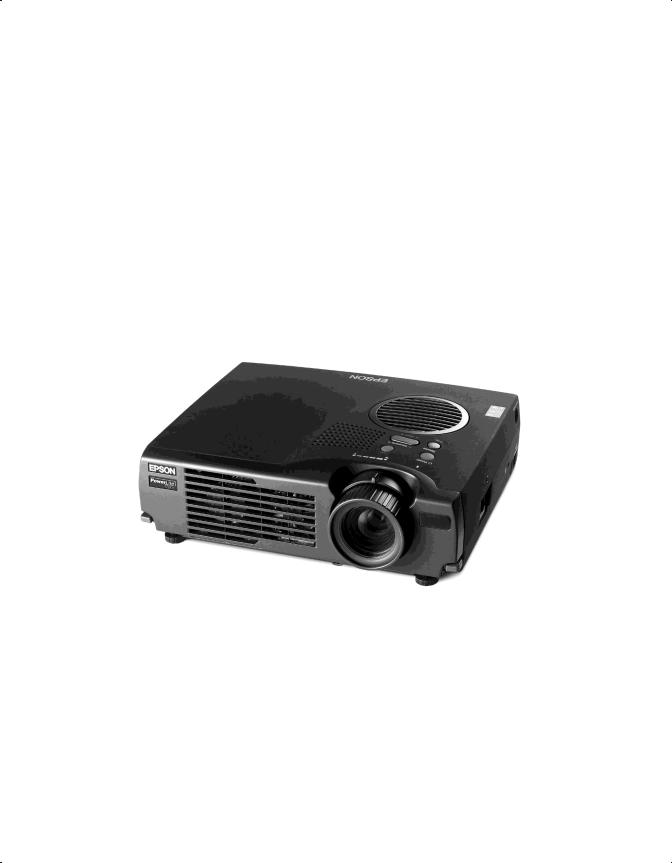
EPSON® PowerLite® 500c/700c/710c
Multimedia Projector
User’s Guide
Supplement

Important Safety Information
WARNING: Never look into the projector lens when the lamp is turned on; the bright light can damage your eyes. Never let children look into the lens when it is on. Never open any cover on the projector, except the lamp and filter covers. Dangerous electrical voltages inside the projector can severely injure you. Except as specifically explained in the User’s Guide or this Supplement, do not attempt to service this product yourself. Refer all servicing to qualified service personnel.
WARNING: The projector and its accessories come packaged in plastic bags. Keep plastic bags away from small children to avoid any risk of suffocation.
Caution: When you replace the lamp, never touch the new lamp with your bare hands; the invisible residue left by the oil on your hands may shorten the lamp life. Use a cloth or glove to handle the new lamp.
Copyright Notice
All rights reserved. No part of this publication may be reproduced, stored in a retrieval system, or transmitted in any form or by any means, electronic, mechanical, photocopying, recording, or otherwise, without the prior written permission of SEIKO EPSON CORPORATION. The information contained herein is designed only for use with this EPSON printer. EPSON is not responsible for any use of this information as applied to other printers.
Neither SEIKO EPSON CORPORATION nor its affiliates shall be liable to the purchaser of this product or third parties for damages, losses, costs, or expenses incurred by purchaser or third parties as a result of: accident, misuse, or abuse of this product or unauthorized modifications, repairs, or alterations to this product, or (excluding the U.S.) failure to strictly comply with SEIKO EPSON CORPORATION’s operating and maintenance instructions.
SEIKO EPSON CORPORATION shall not be liable for any damages or problems arising from the use of any options or any consumable products other than those designated as Original EPSON Products or EPSON Approved Products by SEIKO EPSON CORPORATION.
EPSON is a registered trademark of SEIKO EPSON CORPORATION.
PowerLite is a registered trademark of Epson America, Inc.
General Notice: Other product names used herein are for identification purposes only and may be trademarks of their respective owners. EPSON disclaims any and all rights in those marks.
|
PL500700710C |
Copyright © 2000 by Epson America, Inc. |
1/00 |
2

CContents
ConnectingA to a Desktop Computer
Positioning the Projector . . . . . . . . . . . . . . . . . . . . . . . . . . . . 5 Identifying the Projector Ports . . . . . . . . . . . . . . . . . . . . . . . . 7 Connecting to a PC Desktop Computer . . . . . . . . . . . . . . . . 7 Connecting the Computer Cable . . . . . . . . . . . . . . . . . . 8 Connecting the Audio Cable . . . . . . . . . . . . . . . . . . . . . . 9 Connecting the Cable for Remote Mouse Control . . . . . 9 Connecting to a Desktop Macintosh . . . . . . . . . . . . . . . . . . 10 Connecting the Computer Cable . . . . . . . . . . . . . . . . . 11 Connecting the Audio Cable . . . . . . . . . . . . . . . . . . . . . 13 Connecting the Cable for Remote Mouse Control . . . . 13 Turning the Projector On and Off . . . . . . . . . . . . . . . . . . . 14 Turning On Other Equipment . . . . . . . . . . . . . . . . . . . 16
UsingBthe
Projector
Menus
Changing Menu Settings . . . . . . . . . . . . . . . . . . . . . . . . . . . 18 Video Menu (Computer Image Source) . . . . . . . . . . . . . . . . 20 Video Menu (Video Image Source) . . . . . . . . . . . . . . . . . . . 22 Audio Menu . . . . . . . . . . . . . . . . . . . . . . . . . . . . . . . . . . . . 23 Effect Menu . . . . . . . . . . . . . . . . . . . . . . . . . . . . . . . . . . . . 24 Setting Menu . . . . . . . . . . . . . . . . . . . . . . . . . . . . . . . . . . . . 25 User’s Logo Feature . . . . . . . . . . . . . . . . . . . . . . . . . . . . . . . 26
Capturing the Image . . . . . . . . . . . . . . . . . . . . . . . . . . . 26 Assigning the Image to the No-Signal Message
and/or A/V Mute Button . . . . . . . . . . . . . . . . . . . . 29 Advanced Menu . . . . . . . . . . . . . . . . . . . . . . . . . . . . . . . . . 30 About Menu (Computer Image Source) . . . . . . . . . . . . . . . 31 About Menu (Video Image Source) . . . . . . . . . . . . . . . . . . . 32 Reset All Feature . . . . . . . . . . . . . . . . . . . . . . . . . . . . . . . . . 32
3

TechnicalC
Specifications
Index
General . . . . . . . . . . . . . . . . . . . . . . . . . . . . . . . . . . . . . . . . 33
Projection Lamp . . . . . . . . . . . . . . . . . . . . . . . . . . . . . . . . . 34
Remote Control . . . . . . . . . . . . . . . . . . . . . . . . . . . . . . . . . . 34
Mouse Compatibility . . . . . . . . . . . . . . . . . . . . . . . . . . . . . . 34
Remote IR Receiver . . . . . . . . . . . . . . . . . . . . . . . . . . . . . . . 34
Mechanical . . . . . . . . . . . . . . . . . . . . . . . . . . . . . . . . . . . . . 34
Electrical . . . . . . . . . . . . . . . . . . . . . . . . . . . . . . . . . . . . . . . 34
Environmental . . . . . . . . . . . . . . . . . . . . . . . . . . . . . . . . . . . 34
Safety . . . . . . . . . . . . . . . . . . . . . . . . . . . . . . . . . . . . . . . . . . 35
CE Marking . . . . . . . . . . . . . . . . . . . . . . . . . . . . . . . . . . . . 35
Supported Monitor Displays . . . . . . . . . . . . . . . . . . . . . . . . 35
Computer Connector Pin Assignments . . . . . . . . . . . . . . . . 37
4

|
This appendix describes how to connect the projector to your |
|
|
desktop computer and turn everything on. The projector must |
|
Abe connected to a computer or a video source such as a VCR, |
||
note |
camcorder, digital camera, DVD player, or laser disc player |
|
For instructions on |
||
before it can project any images. You may also want to set up |
||
connecting to a laptop |
||
the projector for one or more of the following: |
||
computer or to external |
||
speakers, see your User’s |
Appendix A: |
||
|
|
Connecting to a Desktop |
|
|
|
Computer |
|
Guide. |
■ Connect the mouse cable to use the remote control as a |
||
wireless mouse. Except for some laptops, this disables your |
|||
|
|
||
|
|
computer’s mouse. You use the remote control’s pointer to |
|
|
|
control the screen cursor. |
|
|
|
■ Provide audio for one or both image sources. The audio |
|
|
|
source can be the computer, video source, or another device |
|
|
|
such as a stereo. |
|
|
|
■ Connect to an external speaker or PA system to amplify the |
|
|
|
audio (see your User’s Guide for instructions). |
|
|
|
Positioning the Projector |
|
|
|
Before you can set up the projector, you need to decide where |
|
|
|
to place it. Keep the following in mind: |
|
|
|
■ Place the projector on a sturdy, level surface. |
|
|
|
■ Make sure the projector is within 10 feet of a grounded |
|
|
|
electrical outlet or extension cord. |
|
|
|
■ Place the computer and/or video source within 5 feet of the |
|
|
|
projector. |
|
|
|
■ Make sure the projector is at right angles to the screen. |
|
|
|
Otherwise, your image will be distorted. |
|
Connecting to a Desktop Computer 5

note
It is easier to position the projector when the screen is directly in front of the room. If the screen is placed diagonally in a corner, it is much more difficult to position the projector perpendicular to the screen and get a non-distorted image.
Most presenters find it convenient to place the projector (and computer) in the front of the room. With this arrangement, the projector is placed close to the screen. You need to raise the front of the projector (by extending the legs) in order to position the image high enough on the screen. Then you can use the projector’s keystone control to correct the distortion caused by tilting up the front of the projector.
The distance between the projector and the screen determines the actual image size. Use the general guidelines in the table below to determine the proper distance.
|
Horizontal distance from projector to |
|
|
screen |
|
|
|
|
Image size |
Minimum |
Maximum |
(diagonal) |
(lens set to W) |
(lens set to T) |
|
|
|
2.2 feet (0.7 meter) |
— |
3.6 feet (1.1 meters) |
|
|
|
2.5 feet (0.8 meter) |
3.6 feet (1.1 meters) |
4.3 feet (1.3 meter) |
|
|
|
3.3 feet (1.0 meter) |
4.8 feet (1.5 meters) |
5.6 feet (1.7 meters) |
|
|
|
5.0 feet (1.5 meters) |
7.5 feet (2.3 meters) |
8.9 feet (2.7 meters) |
|
|
|
6.7 feet (2.0 meters) |
9.8 feet (3.0 meters) |
11.8 feet (3.6 meters) |
|
|
|
8.3 feet (2.5 meters) |
12.5 feet (3.8 meters) |
14.8 feet (4.5 meters) |
|
|
|
12.5 feet (3.8 meters) |
18.7 feet (5.7 meters) |
22.6 feet (6.9 meters) |
|
|
|
16.7 feet (5.1 meters) |
25.3 feet (7.7 meters) |
30.2 feet (9.2 meters) |
|
|
|
25 feet (7.6 meters) |
37.7 feet |
45.3 feet |
|
(11.5 meters) |
(13.8 meters) |
|
|
|
6 Connecting to a Desktop Computer

note
Computer configurations vary. See your computer manual for the location of the ports needed to connect your projector.
Identifying the Projector Ports
The following illustrations identify all the interface ports on the back and side of the projector; you may want to refer to them as you connect your computer or other equipment to the projector.
L-Audio-R
Audio In
Computer
Audio Out |
Out |
In |
|
|
Computer |
|
|
Audio |
|
S-Video |
R |
S-Video |
|
|
|
Audio |
|
|
|
L |
Video 
 Video
Video
Mouse/Com
 Mouse/Com
Mouse/Com
USB Mouse



 USB Mouse
USB Mouse
Power Inlet
Connecting to a PC Desktop Computer
To connect the projector to your PC desktop computer, you need to:
■Connect the computer cable
■Connect the audio cable (if you’ll be projecting with audio)
■Connect the mouse cable (if you want to use the remote control as a mouse)
If you connect the projector to your desktop computer, you cannot view your images on the computer monitor.
Follow the steps in each section for the cables you need to connect.
Connecting to a Desktop Computer 7
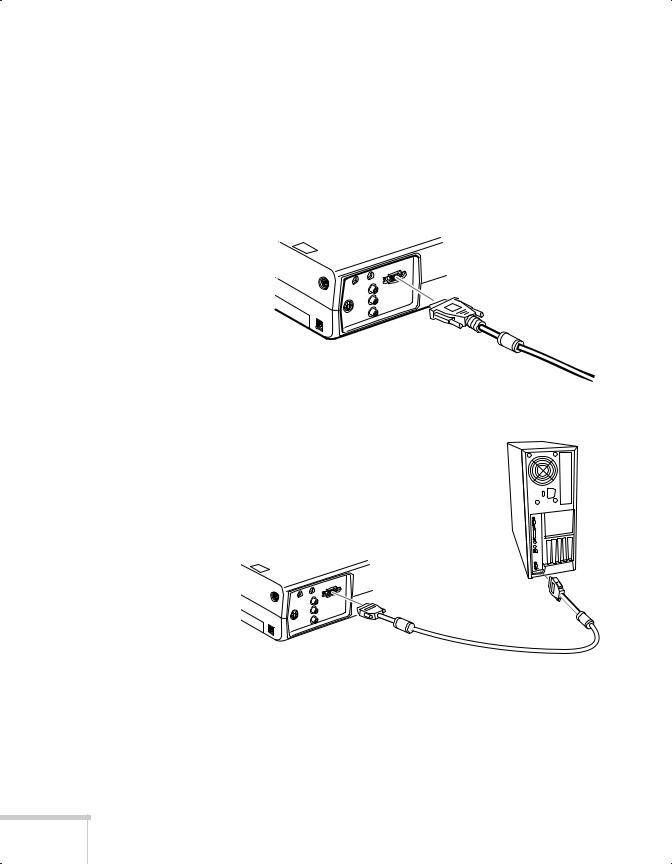
Connecting the Computer Cable
Before you start, make sure your projector, computer, and all peripherals are all turned off.
1.Disconnect the monitor cable from the monitor port on the back of your computer.
2.Connect one end of the projector’s computer cable to the projector’s Computer port.
3.Connect the other end of the cable to your computer’s video (monitor) port.
4. Tighten the screws on all connectors.
If you don’t need to make any other connections, you can plug in your projector and turn it on. See page 14 for instructions.
8 Connecting to a Desktop Computer

note
If you need maximum volume (in a large auditorium, for example), you can also connect external speakers or a public address system to the projector. See your User’s Guide for instructions.
Connecting the Audio Cable
If your presentation includes sound effects or other types of computer audio, you need to connect the audio cable.
1.Connect one end of the audio cable to the Audio In jack on the projector.
Audio in jack
audio cable
2.Connect the other end of the audio cable to the speaker or audio out port on your computer’s sound card.
Connecting the Cable for Remote Mouse Control
Using the remote control as a wireless mouse gives you more flexibility. You can deliver your presentation from anywhere in the room and interact with the audience. You don’t need to stand near your computer or near the projector.
You’ll use different cables and different ports on the projector, depending on whether your computer has a round PS/2 mouse port or a flat USB mouse port.
Mouse/Com
PS/2 mouse port
USB Mouse
USB mouse port
PS/2 mouse cable |
USB mouse cable
Connecting to a Desktop Computer 9
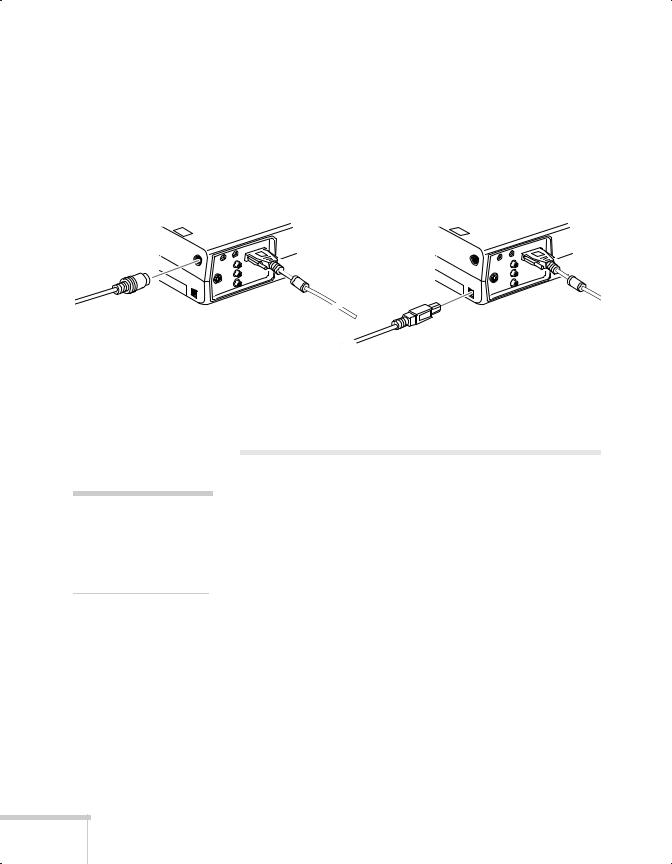
1.Determine which type of mouse port your computer has:
■Round PS/2 mouse port
■Flat USB mouse port
2.Connect one end of the appropriate mouse cable to the PS/2 Mouse/Com port or the USB Mouse port on the projector.
connecting PS/2 mouse cable |
connecting USB mouse cable |
|
|
3.Connect the other end to the mouse port on your computer. (Your computer’s mouse will be disabled while you are using the remote control as a mouse.)
note
Macintosh configurations vary. See your computer manual for the location of the ports needed to connect your projector.
Connecting to a Desktop Macintosh
To connect the projector to your desktop Macintosh,® you need to:
■Connect the computer cable
■Connect the audio cable (if you’ll be projecting with audio)
■Connect the mouse cable (if you want to use the remote control as a mouse)
If you connect the projector to your Macintosh, you cannot view your images on the computer monitor.
Follow the steps in each section for the cables you need to connect.
10 Connecting to a Desktop Computer
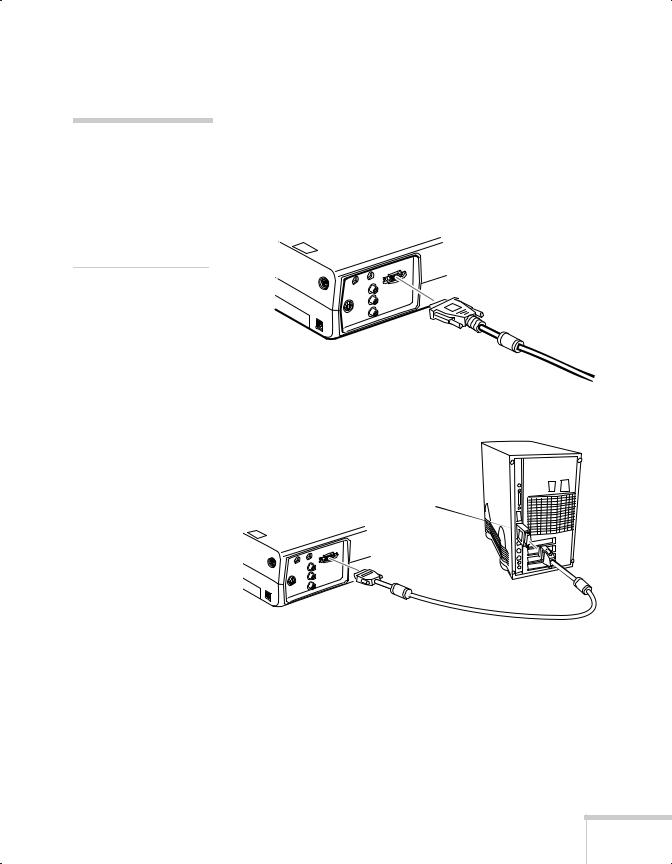
note
If you have an older Macintosh, you may need to use a Macintosh adapter (available from Apple®). Check the documentation for your Macintosh to determine what type of connections are available.
Connecting the Computer Cable
Before you start, make sure your projector, computer, and all peripherals are all turned off.
1.Disconnect the monitor cable from the monitor port on the back of your Macintosh.
2.Connect one end of the computer cable to the projector’s
Computer port.
3.Connect the other end to the monitor port on your Macintosh.
Macintosh adapter, if necessary
Connecting to a Desktop Computer 11
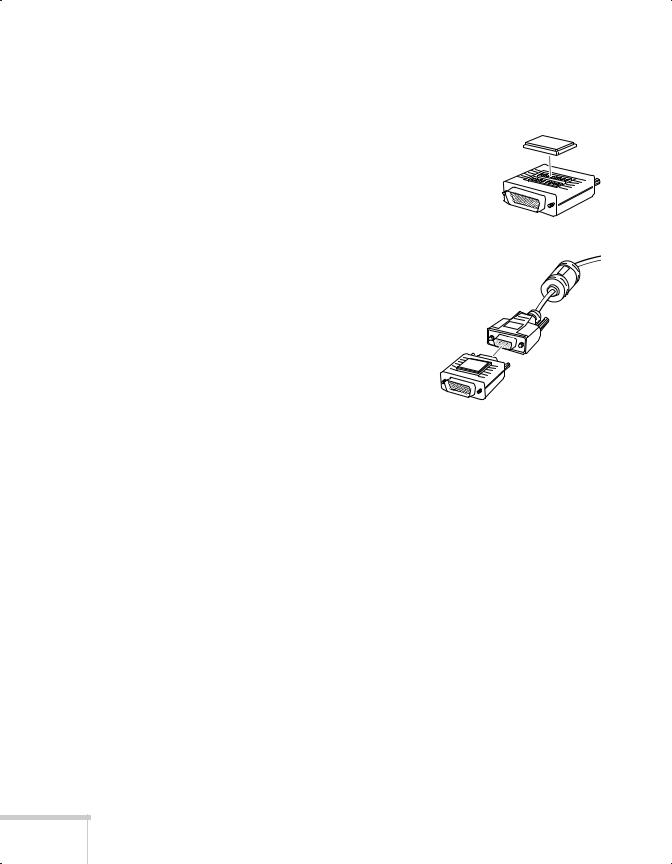
If you can’t connect the projector’s computer cable to your Macintosh, you may need to use a Macintosh adapter (available from Apple).
■Remove the small cover on the Macintosh adapter and set its DIP
switches according to the resolution you want to use (such as 16-inch mode). See your Macintosh documentation for instructions.
■ Connect the small end of the Macintosh adapter to the computer cable.
■ Connect the computer cable (with the Macintosh adapter attached) to the monitor port on your Macintosh.
4. Tighten the screws on all the connectors.
If you don’t need to make any other connections, you can plug in your projector and turn it on. See page 14 for instructions.
12 Connecting to a Desktop Computer

note
If you need maximum volume (in a large auditorium, for example), you can also connect external speakers or a public address system to the projector. See your User’s Guide for instructions.
Connecting the Audio Cable
If your presentation includes sound effects or other types of computer audio, you need to connect the audio cable.
1.Connect one end of the audio cable to the Audio In jack on the projector.
Audio in jack
audio cable
2.Connect the other end of the audio cable to the speaker jack on your Macintosh.
Connecting the Cable for Remote Mouse Control
Using the remote control as a wireless mouse gives you more flexibility. You can deliver your presentation from anywhere in the room and interact with the audience. You don’t need to stand near your Macintosh or near the projector.
You’ll use different cables and different ports on the projector, depending on what type of mouse your Macintosh has.
Mouse/Com
USB Mouse |
standard mouse port |
Mac mouse cable |
USB mouse port |
USB mouse cable |
Connecting to a Desktop Computer 13

1.Determine which type of mouse port your Macintosh has:
■Round mouse port
■Flat USB mouse port
2.Connect one end of the appropriate mouse cable to the standard Mouse/Com port or the USB Mouse port on the projector.
connecting Mac mouse cable |
connecting USB mouse cable |
|
|
3. Connect the other end to the port on your Macintosh.
Turning the Projector On and Off
After you have connected your computer and other equipment, you can plug in the projector and turn it on.
1. Connect the power cable to your projector’s power inlet.



 power light
power light
2.Plug the other end of the cable into a grounded electrical outlet.
The power light on top of the projector turns orange. This indicates that the projector is receiving power, but is not yet turned on.
14 Connecting to a Desktop Computer
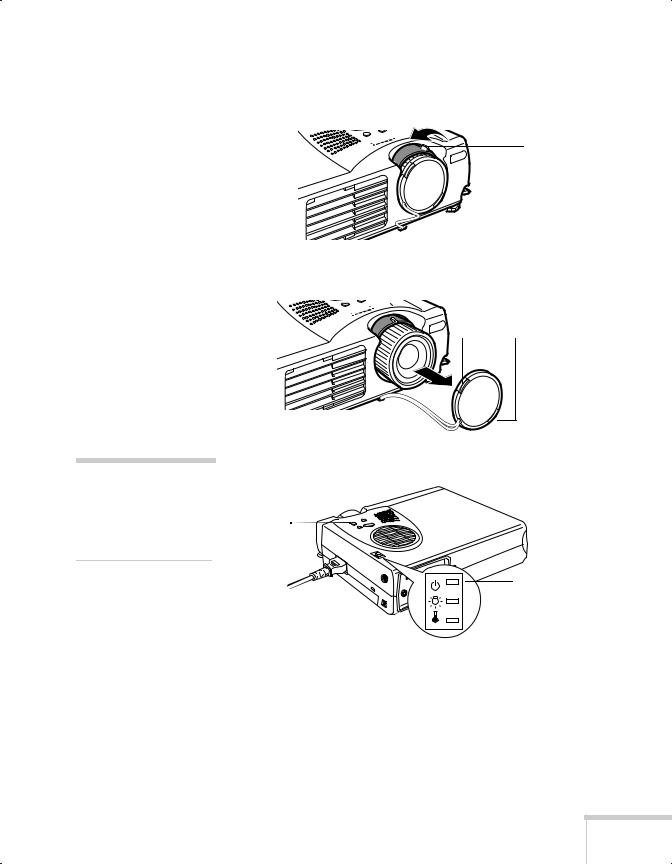
warning
Never look into the lens when the lamp is on. This can damage your eyes, and is especially dangerous for children.
3.Use the tab on the lens ring to rotate the ring and pop out the lens.
tab
4. Squeeze the lens cap tabs and remove the lens cap.
Squeeze here
5. Press the red Power button on top of the projector.
power button
power light
The power light flashes green, and then stays on. You may see a blue screen with the message No Signal displayed. This is normal.
6.Turn on or restart your computer. In a few moments, you should see the computer display projected.
Connecting to a Desktop Computer 15

caution
To avoid damaging the lamp, never unplug the power cord when the power light is green.
When you are ready to turn off the projector, follow these steps:
1.Press the red Power button on top of the projector. You see a confirmation message. (If you don’t want to turn it off, press any other button.)
2.Press the Power button again. The Power light flashes orange for about a minute and the fan gets louder as the projector cools down. When the projector has cooled, the orange light stays on and the fan shuts off.
If you want to turn the projector on again, wait until the orange light stops flashing. Then press the Power button.
3.When you are finished using the projector, replace the lens cap, retract the lens, and unplug the power cord.
Turning On Other Equipment
If you’re using a VCR, other external video source, or additional equipment with the projector, turn on the equipment in this order:
1.Video source
2.External audio source
3.Projector
4.External speakers or PA system
5.Computer
When you’re ready to shut down, turn off the equipment in the reverse order.
16 Connecting to a Desktop Computer

BAppendix B:
Using the Projector
Menus
The on-screen menus let you customize and adjust projector features. The following 8 menus and features are available:
■Video
Controls the look and quality of the projected image (from a computer or video source).
■Audio
Adjusts the volume and tone (treble/bass).
■Effect
Customizes the drawing tools available on the remote control.
■Setting
Adjusts features such as the keystone setting, blank screen color, message prompt, and power management system.
■User’s Logo
Lets you capture and store an image to be displayed with the A/V Mute button, or as the startup screen.
■Advanced
Controls settings such as menu language, use of startup screen, color temperature, and rear or ceiling projection.
■About
Provides information about lamp usage and the current display settings.
■Reset All
Restores the factory defaults for all the projector settings.
Using the Projector Menus 17
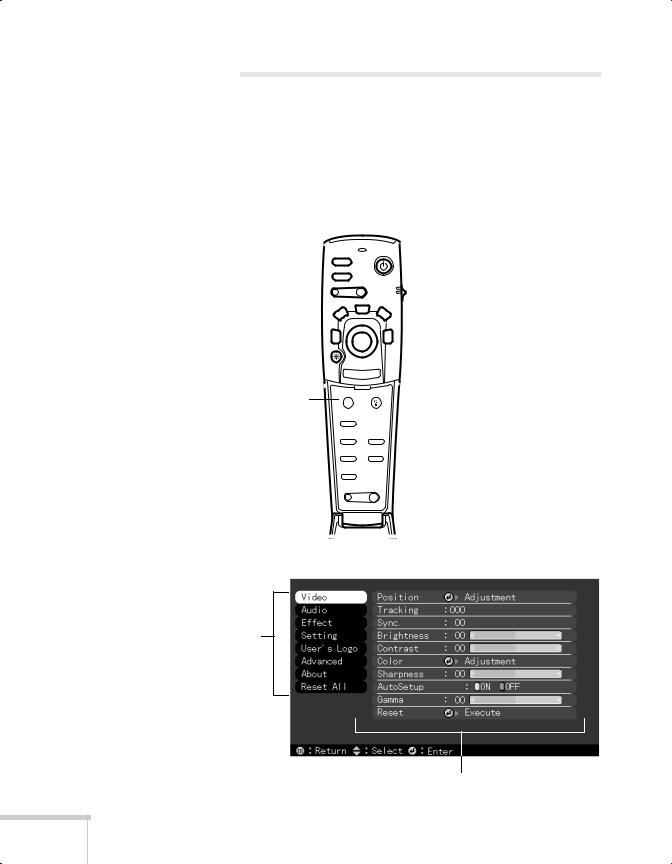
Changing Menu Settings
You use the Menu, Enter and Esc buttons on the remote control to change menu settings.
To change a menu setting:
1.To access the menu system, open the cover on the lower part of the remote control and press the Menu button.
Menu button
|
Power |
Freeze |
|
A/V Mute |
|
E-Zoom |
R/C ON |
OFF |
3 |
4 |
2 |
|
1 |
5 |
Enter |
|
Esc |
|
Menu |
Help |
Comp |
|
S-Video |
Video |
Auto |
Resize |
P in P |
|
- Volume +
You see the following:
menus
Video menu options
18 Using the Projector Menus

note
The options available in some submenus vary, depending on whether the current image source is the computer or a video source.
As you select a menu, a submenu of options appears to the right.
2.Press the bottom of the Enter button (or grasp it between your thumb and finger and tilt it down) to scroll through the menus.
When you highlight a menu, its options are shown on the right.
3.When the menu you want is highlighted, press the center of the Enter button to select it.
The highlight moves to the first option for that menu.
4.Press the bottom of the Enter button (or grasp it between your thumb and finger and tilt it down) to scroll through the options.
5.Press the right or left side of the Enter button (or grasp it between your thumb and finger and tilt it to the side) to change the setting.
6.If you want to go back to the default settings on any menu, select Reset, press Enter, select Yes, and then press Enter.
7.Press the Esc button on the remote to go back to the main menu display. Your changes are saved automatically.
8.Press the Menu button to exit the menu system.
The settings available in each of the menus are described below.
Using the Projector Menus 19
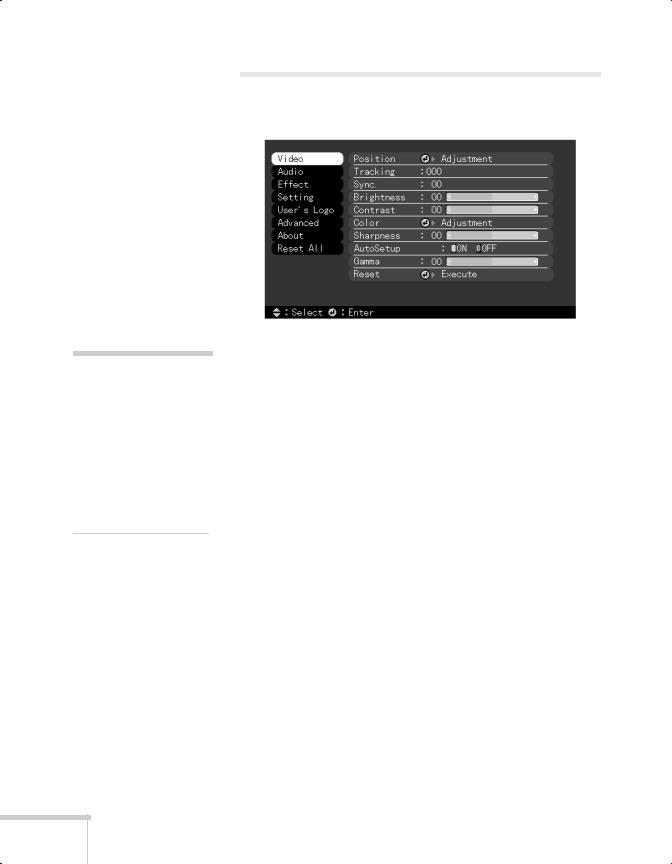
Video Menu (Computer Image
Source)
note
Some options are limited to being enabled (turned on) or disabled (turned off).
The computer must be connected and operating, and the image source on the projector must be set to Computer for you to access these menu options.
The Video menu lets you make adjustments to the projected image. The following options are available when the image source is your computer.
Menu item |
Description |
|
|
Position |
Use the Enter button to move the screen |
|
position in the corresponding direction. |
|
When you finish making adjustments, press the |
|
Esc button. |
|
|
Tracking |
Matches the projector’s internal clock to |
|
various computer graphic signals. Adjust this |
|
setting to remove vertical lines from the image. |
|
|
Sync |
Synchronizes with the tracking signal sent from |
|
the computer. Adjust this setting to correct |
|
fuzziness or screen flicker. |
|
|
Brightness |
Lightens or darkens the overall image. Increase |
|
brightness to lighten an image, or decrease it to |
|
darken the image. |
|
|
Contrast |
Adjusts the difference between light and dark |
|
areas. Increase the contrast to make light areas |
|
lighter and dark areas darker. Decrease it to |
|
minimize the difference between light and dark |
|
areas. |
|
|
20 Using the Projector Menus

Menu item |
Description |
|
|
Color |
Adjusts the color balance (red:green:blue) of |
|
the input source. |
|
Increase the color setting for more intense |
|
color on the screen, and lower the setting for |
|
less intense color. |
|
When you finish making adjustments, press the |
|
Esc button. |
|
|
Sharpness |
Adjusts the sharpness of the screen image. |
|
|
Auto Setup |
Set to On to have the computer automatically |
|
optimize the image for projection. |
|
|
Gamma |
Adjusts the projected image for natural |
|
coloration. |
|
|
Reset |
Returns all menu items to their initial factory |
|
defaults. |
|
|
Using the Projector Menus 21

note
The projector’s image source must be set to Video, and the video source (such as a VCR or camcorder) must be connected and operating for you to access these menu options. For example, the projector must actually be projecting the image from your video tape if you’re using a VCR.
Video Menu (Video Image Source)
The Video menu lets you make adjustments to the projected image. The following options are available when the image source is Video.
Menu item |
Description |
|
|
Position |
Use the Enter button to move the screen |
|
position in the corresponding direction. |
|
When you finish making adjustments, press the |
|
Esc button. |
|
|
Brightness |
Lightens or darkens the overall image. Increase |
|
brightness to lighten an image, or decrease it to |
|
darken the image. |
|
|
Contrast |
Adjusts the degree of difference between light |
|
and dark areas. Increase the contrast to make |
|
light areas lighter and dark areas darker. |
|
Decrease it to minimize the difference between |
|
the lightest and darkest areas of the image. |
|
|
Color |
Adjusts color density. Increase the setting for |
|
darker and more opaque colors. Decrease it for |
|
lighter and less opaque colors. |
|
|
Tint |
Adjusts the red-green color balance of the |
(NTSC only) |
screen. Increase tint to add more green, or |
|
decrease it to add more red. |
|
|
Sharpness |
Adjusts the sharpness of the screen image. |
|
|
Gamma |
Adjusts the projected image for natural |
|
coloration. |
|
|
Mode |
Specifies the image signal mode: Auto, NTSC, |
|
NTSC4.43, PAL, M-PAL, N-PAL, PAL 60, |
|
SECAM. |
|
|
Reset |
Returns all menu items to their initial factory |
|
defaults. |
|
|
22 Using the Projector Menus
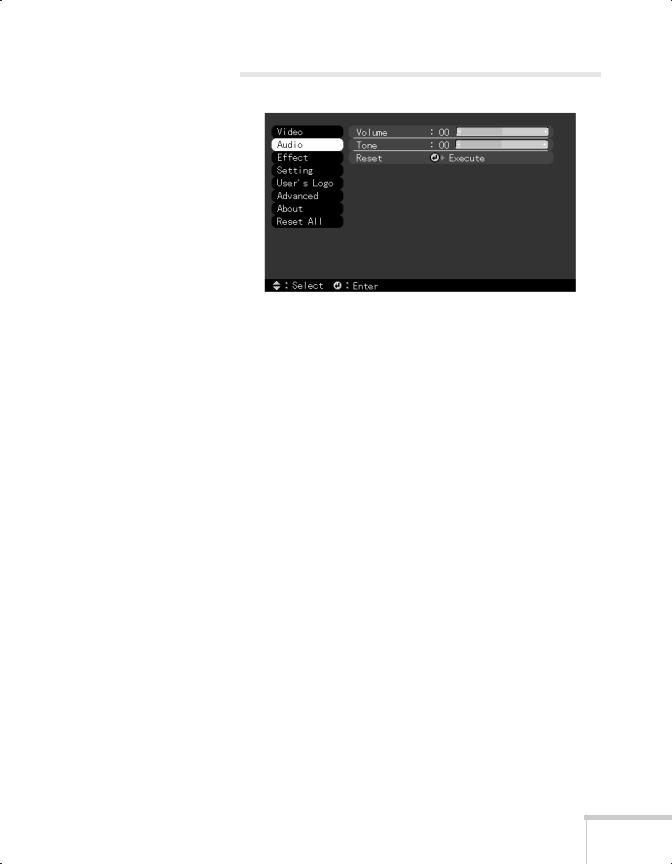
Audio Menu
Use the Audio menu to adjust the sound volume and quality of your audio.
Menu item |
Description |
|
|
Volume |
Adjusts the volume level for the projector’s |
|
speaker and audio-out terminal. |
|
Increase the setting to raise the volume, or |
|
decrease it to lower the volume. |
|
|
Tone |
Adjusts the sound quality. Move left to increase |
|
bass and right to increase treble. |
|
|
Reset |
Returns all menu items to their initial factory |
|
defaults. |
|
|
Using the Projector Menus 23

Effect Menu
The Effect menu lets you customize the drawing tools available on the remote control.
Menu item |
Description |
|
|
Cursor/ |
Selects the stamp you want to use as the |
Stamp |
cursor graphic and lets you enlarge it. |
|
|
Box |
Selects a box color and shape. |
|
|
Marker |
Selects the marker (horizontal or vertical lines) |
|
color and width (from 2 to 32 pixels). |
|
|
Freehand |
Selects the color and width for freehand lines |
|
(2 to 148 pixels). |
|
|
Cursor Speed |
Adjusts the cursor speed to Low, Middle, or |
|
High. |
|
|
Reset |
Returns all menu items to their initial factory |
|
defaults. |
|
|
24 Using the Projector Menus

Setting Menu
The Setting menu allows you to set or adjust various projector options.
Menu item |
Description |
|
|
Keystone |
Adjusts a trapezoid (distorted) image to a 4:3 |
|
rectangle, correcting up to a ± 15° tilt. |
|
|
P-in-P |
Selects the image source (composite or |
|
S-Video) for the picture-in-picture subscreen. |
|
|
No-Signal |
Specifies whether no screen, a black screen, a |
Msg |
blue screen, or a user logo is displayed when |
|
the projector is not receiving a signal. |
|
|
Prompt |
Turns off the message identifying the image |
|
source (computer or video). |
|
|
A/V Mute |
Specifies whether a blue, black, or user logo |
|
screen is displayed when the A/V mute button |
|
is pressed. |
|
|
Power Mgmt |
Turns on the power management system |
Sys |
which works with your computer’s power |
|
management. |
|
|
Reset |
Returns all menu items to their initial factory |
|
defaults. |
|
|
Using the Projector Menus 25

User’s Logo Feature
The User’s Logo feature allows you to transfer any image on your computer to the projector, and then use it as the screen displayed when the projector is not receiving a signal. You can also set it as a startup screen or to be displayed when you press the A/V Mute button on the remote. The image can be a company logo, slogan, photograph, or another other image you want to use.
Capturing the Image
You start by displaying the image you want to use on the projector. You can use an image from either a computer or video source such as a VCR or digital camera. Then follow these steps to capture the image and transfer it to the projector:
1.Press the Menu button. You see the main menu listing, with the Video menu highlighted.
2.Press the bottom edge of the Enter button (or move it down) to highlight the User’s Logo menu.
26 Using the Projector Menus

3.Press Enter to select this feature. You see the following message:
4.Select Yes and press Enter. A selection box displays over the image.
5.Use the Enter button on the remote control to select the area of the image you want to use. Once you have selected the entire area, press Enter.
6.When you see the message “Do you use this image?” select Yes and press Enter. If you want to change the area selected, select No and repeat step 5. You see the following:
7.Use the Enter button on the remote control to select a zoom rate (display size), and then press Enter.
Using the Projector Menus 27

8.When the following message appears, select Yes and press
Enter.
Saving the logo may take a few moments. Do not use the projector or other sources (computer, video, speaker, etc.) while the logo is being saved.
9.When you see the following message, press the Menu or Enter button to redisplay the main menu.
28 Using the Projector Menus

note
You can also set up your image as a startup screen. Use the Advanced menu to enable the startup screen.
Assigning the Image to the No-Signal Message and/or A/V Mute Button
After your image is saved, you can set it up as the no-signal message and/or the screen that’s displayed when you press the
A/V Mute button.
1.Press the Menu button. You see the main menu listing, with the Video menu highlighted.
2.Press the bottom edge of the Enter button (or tilt it down) to highlight the Setting menu.
3.Press the Enter button to select the Setting menu.
4.Press the bottom edge of the Enter button (or tilt it down) to highlight No-Signal Msg.
5.Press the right side of the Enter button to select Logo. This sets your image as the screen displayed when the projector is not receiving a signal.
6.If you want to set up your image as the A/V mute display, press the bottom edge of the Enter button (or tilt it down) to highlight A/V Mute.
7.Press the right side of the Enter button to select Logo. This sets your image as the screen displayed when you press the
AV/Mute button.
8.When you’re finished, press Esc or Menu.
To test your setting, press the A/V Mute button to display your image. Press it again to turn off the image.
Using the Projector Menus 29
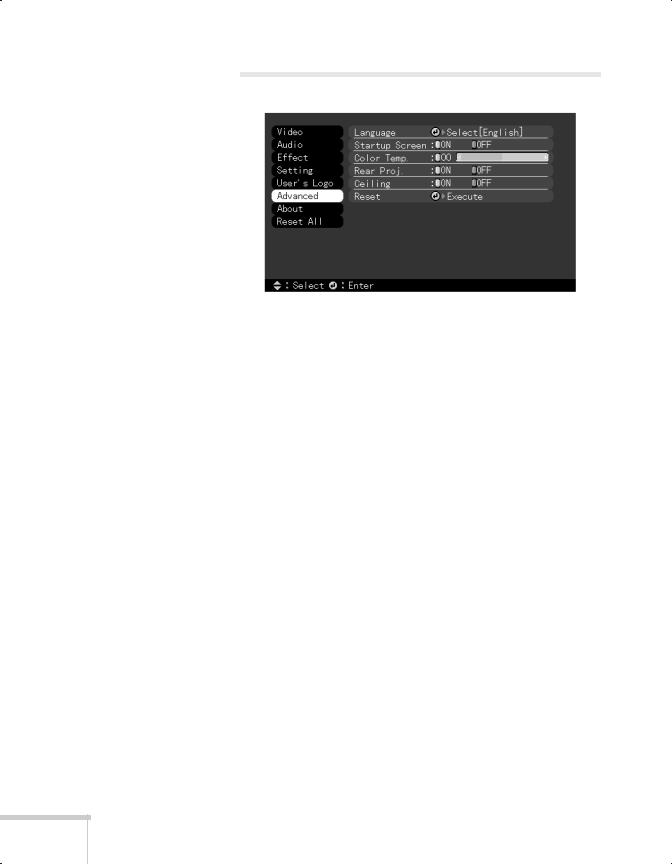
Advanced Menu
The Advanced menu lets you set additional projector options.
Menu item |
Description |
|
|
Language |
Selects the language to be used in the menus: |
|
Japanese, English, French, German, Italian, |
|
Spanish, Portuguese, Chinese, or Korean. |
|
|
Startup |
Displays the image you have saved as a user |
Screen |
logo during the projector’s startup. |
|
|
Color Temp |
Adjusts the whiteness of the screen. Positive |
|
color temperature values provide a cold white; |
|
negative values provide a warmer white. |
|
|
Rear Proj. |
Mirrors the projected image so it looks correct |
|
when you’re projecting from behind onto a |
|
translucent screen. Selecting ON turns |
|
mirroring on, while OFF turns it off (for a normal |
|
image). |
|
|
Ceiling |
Flips the projected image so it looks correct |
|
when the projector is mounted upside-down |
|
from the ceiling. Selecting ON turns the feature |
|
on, while OFF turns it off (for a normal image). |
|
|
Reset |
Returns all Advanced menu items to their initial |
|
factory defaults. |
|
|
30 Using the Projector Menus
